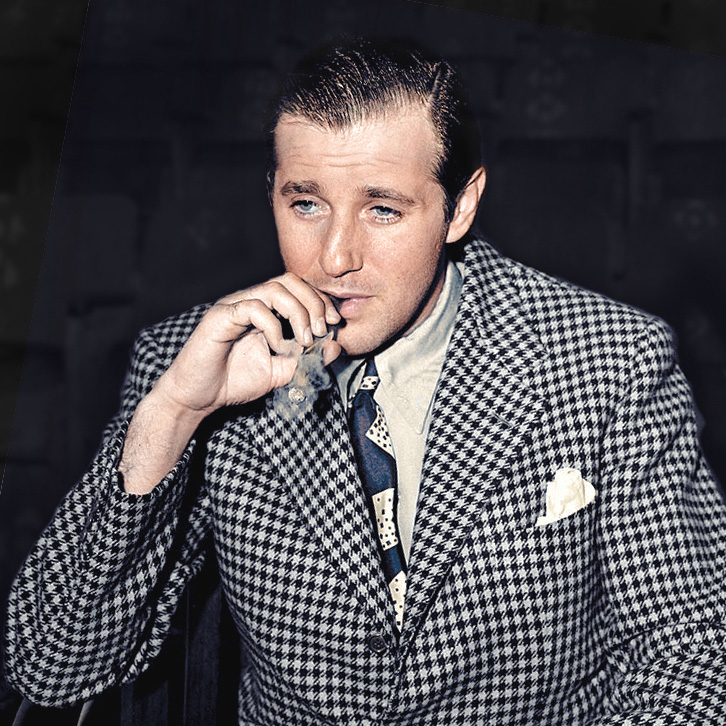It started with a street punk’s love of nickelodeons and their silent stars, such as Theda Bara and Rudolph Valentino: immigrants, or children of immigrants. Ben “Bugsy” Siegel, whose parents had come to the Lower East Side from Galicia, earned the nickname he hated for the temper that made his face glow and the penchant for violence that all too often made him seem, as one F.B.I. agent later put it, insane “along certain lines.”
As he and his childhood pal Meyer Lansky went from squeezing pushcart peddlers to profiting royally from Prohibition, Siegel often showed a charming side, cutting a swath through speakeasies in dark pin-striped suits, monogrammed shirts, and custom-made alligator shoes. The real surprise, though, was that he wanted to act—and nearly made his dream come true.

Siegel knew one person in Hollywood when he arrived, in 1933: his fellow street-urchin-made-good, George Raft. “Damned few people knew what made him tick,” Raft later said of Siegel. “But I did.” Raft’s career as a gangster turned actor was what Siegel yearned for himself, even as he made a second fortune in racketeering and the race wire. Raft had gotten his break with Scarface in 1932 and was all but defining film noir with his gangster drawl.
The real surprise was that he wanted to act—and nearly made his dream come true.
Siegel made his move by starting a union for stage extras, after clearing it with the East Coast Mob, and urged studio execs to chip in. But he also showed up one day on the set of a film Raft was making with Marlene Dietrich. When the director called “Break,” Siegel opened a briefcase to reveal his own 16-mm. camera. To Raft’s astonishment, Siegel re-enacted Raft’s part in the scene he’d just witnessed. He memorized the lines and even used Raft’s gestures. Not only that, he was pretty good!
Raft was smart enough to let his pal’s ambition expire on its own. The very idea of Bugsy Siegel auditioning was alarming: if a casting agent showed anything less than sheer deference, he might end up dead. Instead, Siegel became an actor manqué, with Hollywood as his stage.
A Star Is Born
Siegel started every day by swimming laps and working out at the local Y.M.C.A. From an illuminated glass case in the master bedroom of his mansion in Holmby Hills, he chose the day’s $25 monogrammed shirt and $200 Louis Roth suit. Then it was off to Drucker’s, one of Hollywood’s top barbershops, usually for the works: a haircut, shave, manicure, shoulder massage, and shoeshine. Another barber later recalled Siegel sitting jaybird naked in the chair while his needs were attended to, then standing in the barber’s full-length mirror to admire the results.
Siegel became an actor manqué, with Hollywood as his stage.
No less important was Siegel’s nighttime regimen. He started by rubbing cream over his face to keep his skin smooth. Then he fitted himself with an elastic chinstrap to keep his jowls from sagging, and slipped between the covers with a copy of Reader’s Digest. He especially liked the section “It Pays to Increase Your Word Power,” and practiced the new words he saw, like an actor practicing his diction. All this was vanity, but not just vanity. Siegel sensed the power he radiated with his Hollywood-star physique, his vulpine good looks, and his visible grooming. No one he met with on his rounds wanted to see even the hint of a scowl cross those features.

In a sense, Siegel became the Hollywood actor he wanted to be. Actors from Cary Grant and Clark Gable to Frank Sinatra came to his mansion to socialize and gamble. When Siegel opened the Flamingo in 1946 and changed Vegas casino culture forever, transforming sawdust joints into lushly carpeted mega-hotels, Hollywood followed him there too.
And when, aged 41, he had spent too much of his fellow gangsters’ money and paid the ultimate price on a June night in 1947, he was buried in the Jewish section of the Hollywood Forever Cemetery. Already, the place included Rudolph Valentino and Douglas Fairbanks. They would be joined by Judy Garland, Marion Davies, Fay Wray, Peter Lorre, John Huston, and others. Like every other Jewish gangster of his brief, violent generation, Bugsy Siegel had gone legit at last.
Michael Shnayerson is a journalist and the author of numerous books, including Boom: Mad Money, Mega Dealers and the Rise of Contemporary Art. Bugsy Siegel: The Dark Side of the American Dream is out now from Yale University Press

